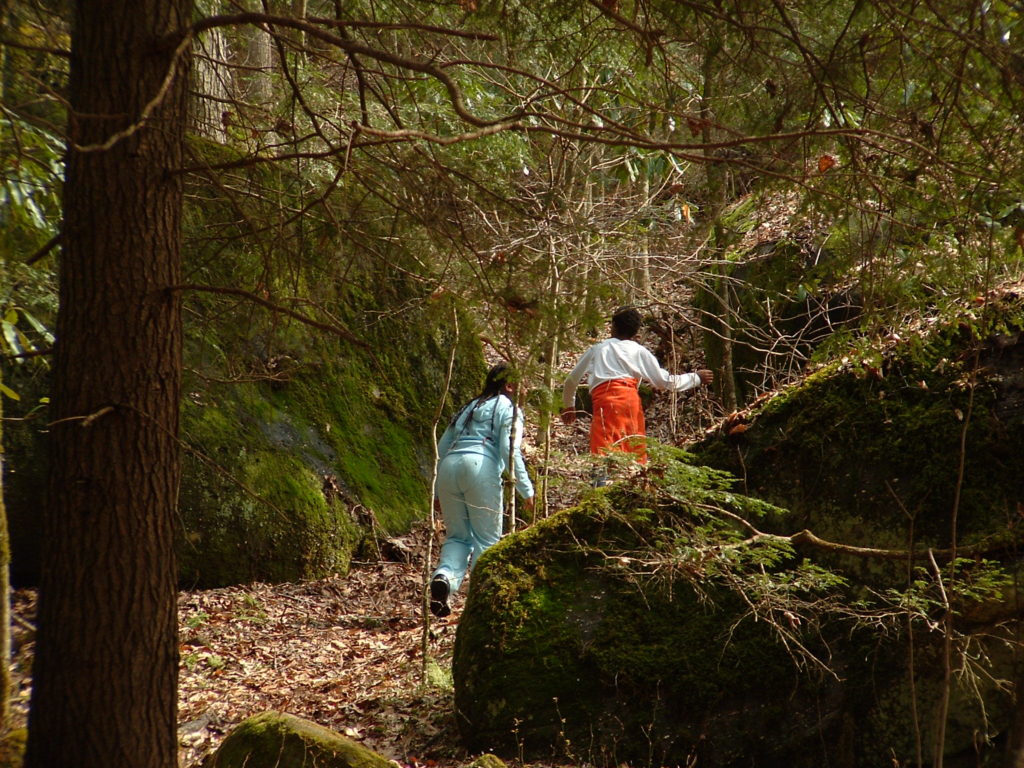Pine Mountain Settlement School
Series 09: BIOGRAPHY – Staff
Series 22: ENVIRONMENTAL EDUCATION
Mary Rogers
EE Planning and Programming Notes
1970s

Environmental Education, Coleridge School. [picture-140.jpg]
MARY ROGERS EE Planning and Programming Notes
TAGS: Mary Rogers, EE planning and programming notes, environmental education, curriculum, Morton Arboretum, Kentucky Nature Conservancy, planning document
Considerable planning has gone into programming at Pine Mountain. The most remarkable discovery in this planning process is the consistency in the programmatic objectives.
In this brief two-page planning document for the Environmental Education program, the core programs of the 1970s may be found. The document also includes some thoughtful analysis of how those programs might be expanded and still include the central objectives that previous years found successful.
Of interest is the fact that #1 on the list is blank. This suggests that the order of this “list” may not be one of priority. However, it is obviously a central planning document and one that also tries to evaluate the existing programs against future needs.
MARY ROGERS EE Planning and Programming Notes
Mary’s thoughtful notes follow:
MARY ROGERS
1. [blank]
2. The role the Appalachian environment in shaping the Appalachian culture and the impact of the developing cultures on the Appalachian environment both seem as part of nature’s and worldwide picture as people’s attitudes to the environment; their use and abuse of it.
3. Research on the original forms of the Appalachian dance (N.K Step Thesis)
4. Research on the [PMSS] settlement school and its curriculum (N.K Step Thesis)
-
-
- Annual December college course on culture in the Appalachian environment, chief features [of] the course is taught by Native Appalachians who are or have been employed in the field to which they speak. (See enclosed folders) Text books – Harry Caudill‘s books (credit Transylvania)
- Annual Jan[uary] college course on … (Credit Berea College)
- A spinning bee weekend in Summer… from the wool of the sheep to the woven product
- A workshop in edible plant of Appalachian
- A workshop in medicinal plant of Appalachia
- 2 wildflower [workshops] and one Fall color weekend to educate in the Appalachian flora and fauna. In addition we have arranged courses for such groups as the Morton [?] Arboretum, the Kentucky Nature Conservancy, various college groups, as well as high school and grade school classes to acquaint them with a variety of subjects in the Appalachian setting and cultural heritage.
- We have a special collection containing:
-
a. A few rare and out of print books on Appalachian history, topography, sociology, literature, rock arts, etc.
b. Files of clippings and original letters picturing the area, dating from 1913, which contain much “oral history from pre-tape recorder days,”
c. Photo files of both School and neighborhood dating from 1913.
d. Various small “community” films taken by High School student in the 1930s on the neighborhood and its crafts and the School.
These are all available, under supervision, to students who come with adequate credentials. [No longer available.]
10. The knowledge of the prehistory of the Appalachian region and its Indians is very sketchy, and there are sites that need scientific excavation before they are destroyed by new building, strip mining, and vandals.
11. (6.) We find having a world under challenge of Environmental questions in mind makes Appalachian studies relevant to a larger area, a study in microcosm of the kind of challenges, values students will be faced with wherever they may go. For those present, within the area, it fosters a love for and understanding of their own surrounding and a sense of belonging to something intensely worthwhile. To those from outside it brings a sense of identity with real people and real place as found in text books
c. The response is nothing one can measure, but an indication of the response may be seen in the fact that members of those who attend courses have come back as interns to give their services in helping the program.
See Also:
MARY ROGERS Staff
MARY ROGERS Correspondence
MARY ROGERS Drawings
ENVIRONMENTAL EDUCATION
ENVIRONMENTAL EDUCATION The Green Book 1974
Return To:
ENVIRONMENTAL EDUCATION Guide 1972 to present

